Macroeconomic Challenges and Government Responses in Japan: A Report
VerifiedAdded on 2023/05/28
|11
|3361
|124
Report
AI Summary
This report provides a comprehensive analysis of Japan's macroeconomic challenges, focusing on the impact of the Bank of Japan's monetary policies and the government's fiscal responses. It examines key issues such as fluctuating inflation, inflexible interest rates, and their effects on investment, capital markets, and aggregate demand. The report delves into the causes of these problems, including unchanged government policies, the central bank's communication issues, and credit crunches. It assesses the societal and economic impacts, including stagnant GDP growth, reduced savings rates, and rising unemployment. Furthermore, the report details the actions undertaken by the government to address these challenges, such as introducing flexibility in interest rates, and discusses the long-term implications of these policies on the Japanese economy and its global environment. The analysis includes references to relevant economic models and academic research, providing a detailed overview of the situation.
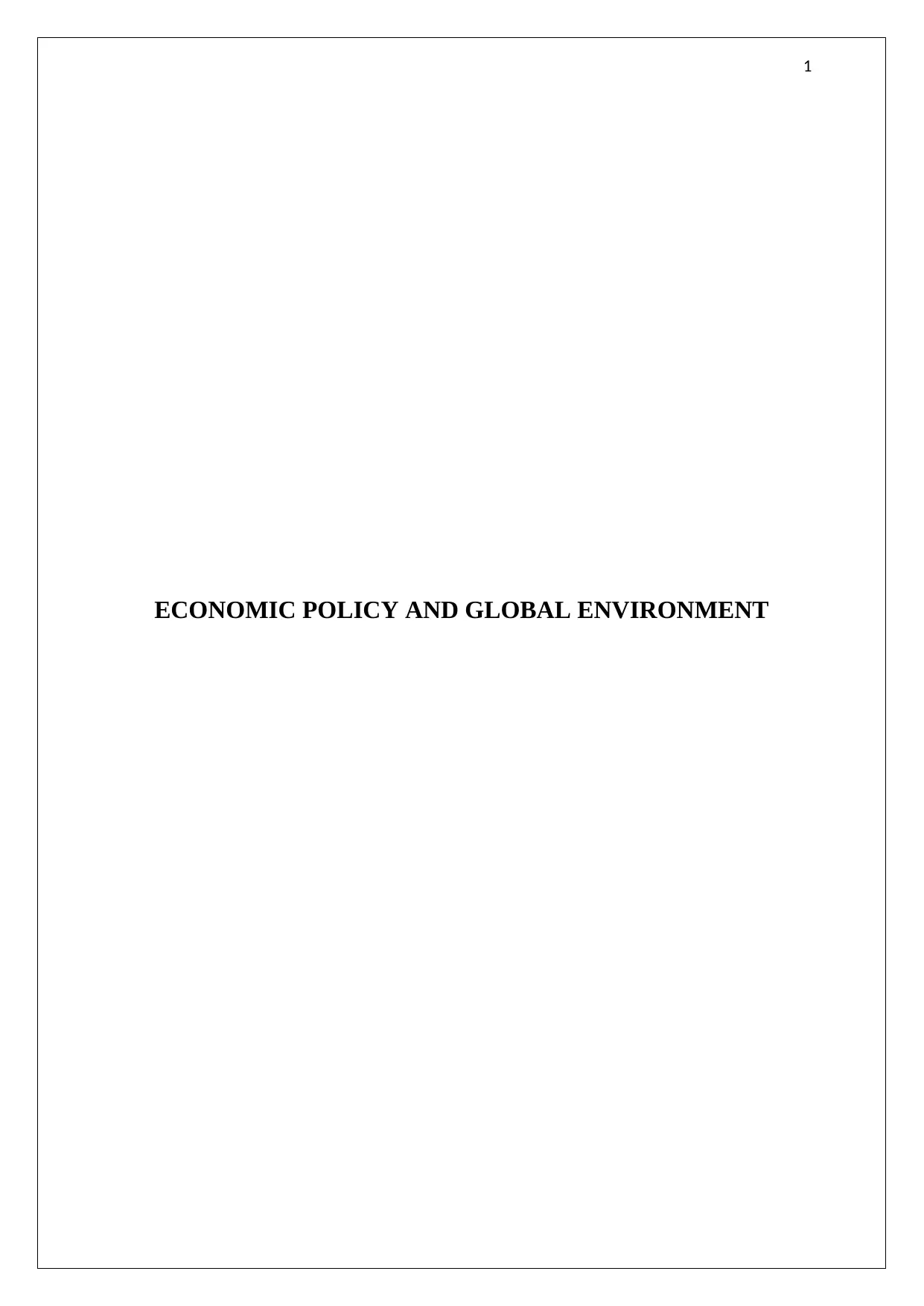
1
ECONOMIC POLICY AND GLOBAL ENVIRONMENT
ECONOMIC POLICY AND GLOBAL ENVIRONMENT
Paraphrase This Document
Need a fresh take? Get an instant paraphrase of this document with our AI Paraphraser
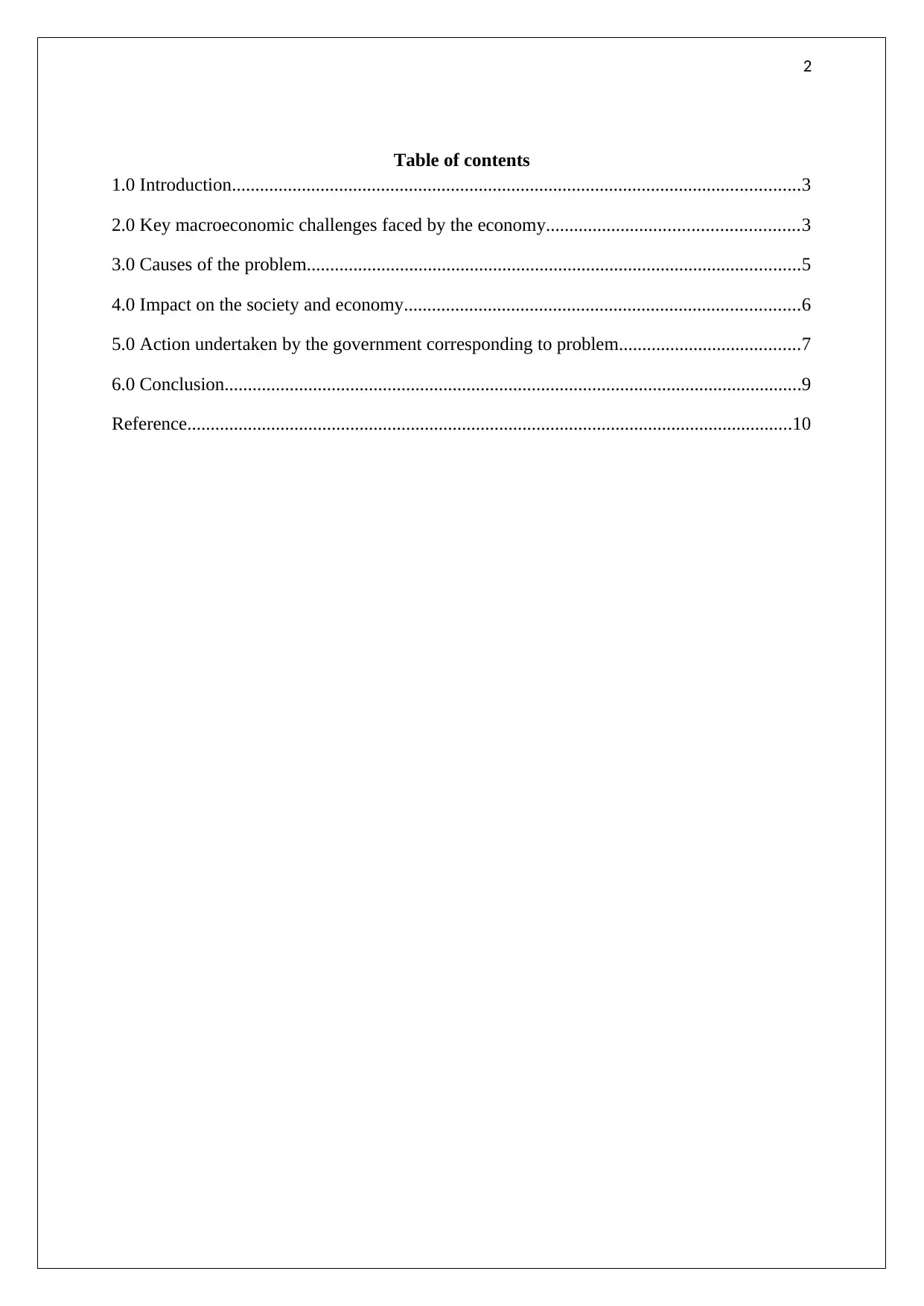
2
Table of contents
1.0 Introduction..........................................................................................................................3
2.0 Key macroeconomic challenges faced by the economy......................................................3
3.0 Causes of the problem..........................................................................................................5
4.0 Impact on the society and economy.....................................................................................6
5.0 Action undertaken by the government corresponding to problem.......................................7
6.0 Conclusion............................................................................................................................9
Reference..................................................................................................................................10
Table of contents
1.0 Introduction..........................................................................................................................3
2.0 Key macroeconomic challenges faced by the economy......................................................3
3.0 Causes of the problem..........................................................................................................5
4.0 Impact on the society and economy.....................................................................................6
5.0 Action undertaken by the government corresponding to problem.......................................7
6.0 Conclusion............................................................................................................................9
Reference..................................................................................................................................10
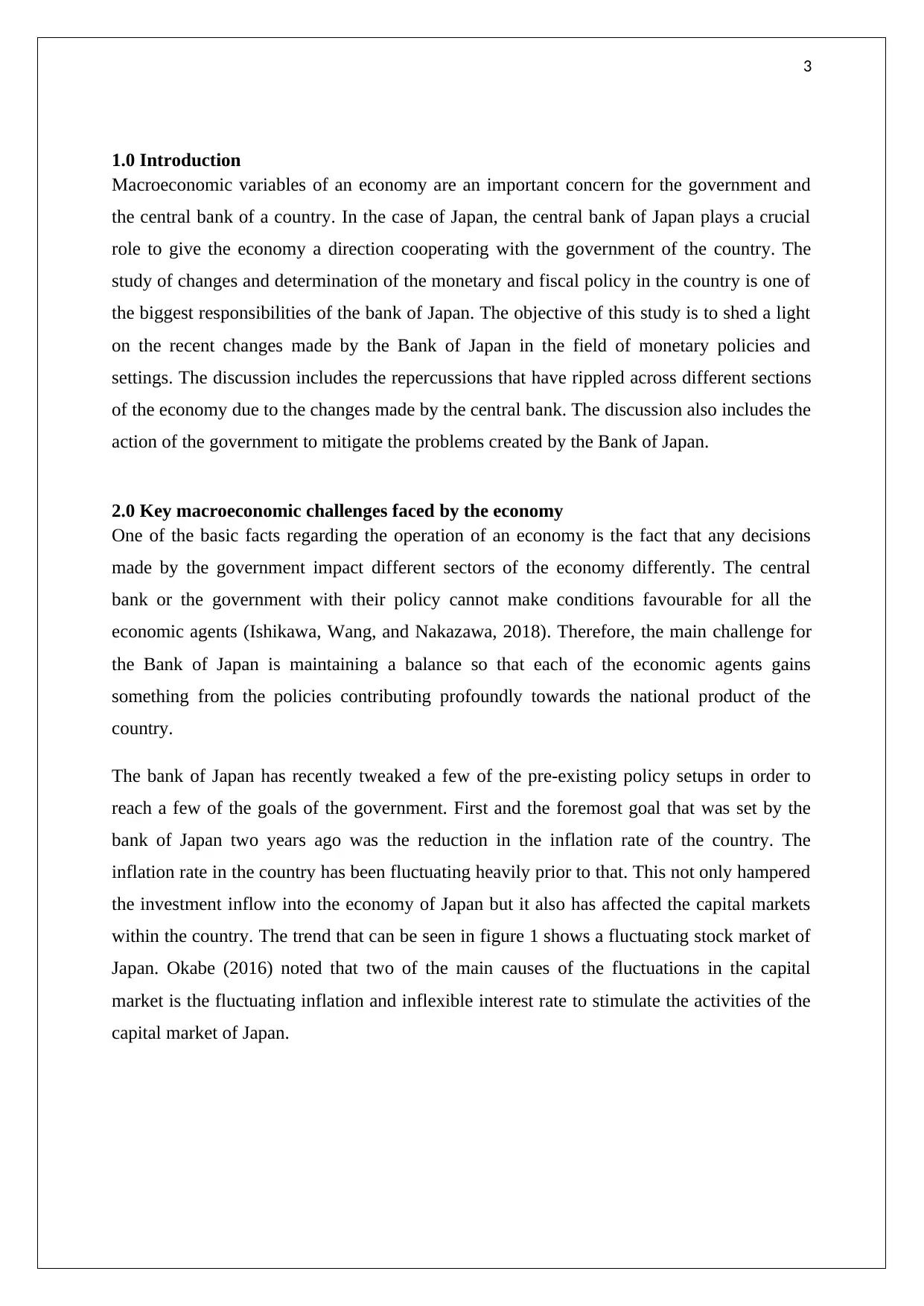
3
1.0 Introduction
Macroeconomic variables of an economy are an important concern for the government and
the central bank of a country. In the case of Japan, the central bank of Japan plays a crucial
role to give the economy a direction cooperating with the government of the country. The
study of changes and determination of the monetary and fiscal policy in the country is one of
the biggest responsibilities of the bank of Japan. The objective of this study is to shed a light
on the recent changes made by the Bank of Japan in the field of monetary policies and
settings. The discussion includes the repercussions that have rippled across different sections
of the economy due to the changes made by the central bank. The discussion also includes the
action of the government to mitigate the problems created by the Bank of Japan.
2.0 Key macroeconomic challenges faced by the economy
One of the basic facts regarding the operation of an economy is the fact that any decisions
made by the government impact different sectors of the economy differently. The central
bank or the government with their policy cannot make conditions favourable for all the
economic agents (Ishikawa, Wang, and Nakazawa, 2018). Therefore, the main challenge for
the Bank of Japan is maintaining a balance so that each of the economic agents gains
something from the policies contributing profoundly towards the national product of the
country.
The bank of Japan has recently tweaked a few of the pre-existing policy setups in order to
reach a few of the goals of the government. First and the foremost goal that was set by the
bank of Japan two years ago was the reduction in the inflation rate of the country. The
inflation rate in the country has been fluctuating heavily prior to that. This not only hampered
the investment inflow into the economy of Japan but it also has affected the capital markets
within the country. The trend that can be seen in figure 1 shows a fluctuating stock market of
Japan. Okabe (2016) noted that two of the main causes of the fluctuations in the capital
market is the fluctuating inflation and inflexible interest rate to stimulate the activities of the
capital market of Japan.
1.0 Introduction
Macroeconomic variables of an economy are an important concern for the government and
the central bank of a country. In the case of Japan, the central bank of Japan plays a crucial
role to give the economy a direction cooperating with the government of the country. The
study of changes and determination of the monetary and fiscal policy in the country is one of
the biggest responsibilities of the bank of Japan. The objective of this study is to shed a light
on the recent changes made by the Bank of Japan in the field of monetary policies and
settings. The discussion includes the repercussions that have rippled across different sections
of the economy due to the changes made by the central bank. The discussion also includes the
action of the government to mitigate the problems created by the Bank of Japan.
2.0 Key macroeconomic challenges faced by the economy
One of the basic facts regarding the operation of an economy is the fact that any decisions
made by the government impact different sectors of the economy differently. The central
bank or the government with their policy cannot make conditions favourable for all the
economic agents (Ishikawa, Wang, and Nakazawa, 2018). Therefore, the main challenge for
the Bank of Japan is maintaining a balance so that each of the economic agents gains
something from the policies contributing profoundly towards the national product of the
country.
The bank of Japan has recently tweaked a few of the pre-existing policy setups in order to
reach a few of the goals of the government. First and the foremost goal that was set by the
bank of Japan two years ago was the reduction in the inflation rate of the country. The
inflation rate in the country has been fluctuating heavily prior to that. This not only hampered
the investment inflow into the economy of Japan but it also has affected the capital markets
within the country. The trend that can be seen in figure 1 shows a fluctuating stock market of
Japan. Okabe (2016) noted that two of the main causes of the fluctuations in the capital
market is the fluctuating inflation and inflexible interest rate to stimulate the activities of the
capital market of Japan.
⊘ This is a preview!⊘
Do you want full access?
Subscribe today to unlock all pages.

Trusted by 1+ million students worldwide
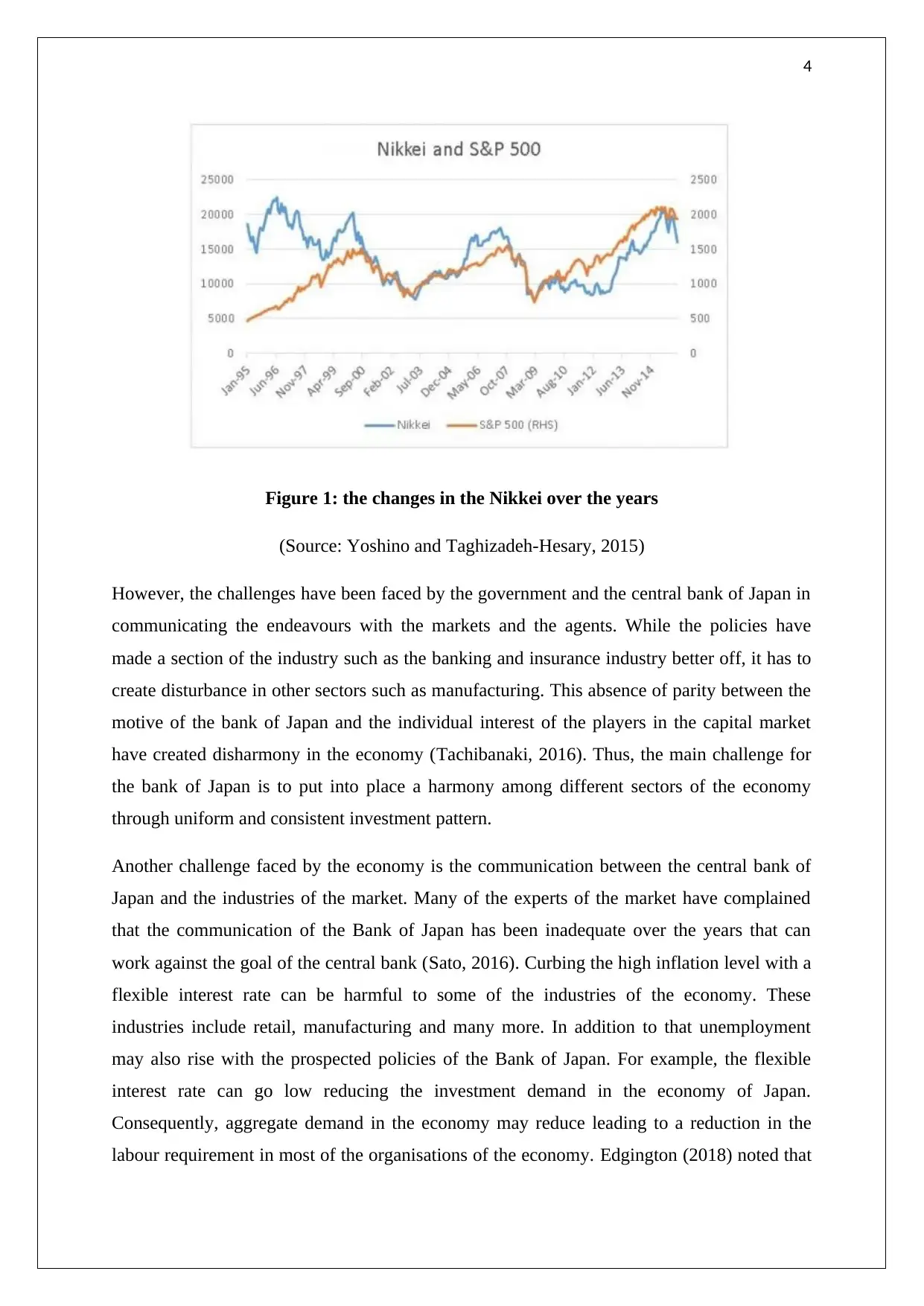
4
Figure 1: the changes in the Nikkei over the years
(Source: Yoshino and Taghizadeh-Hesary, 2015)
However, the challenges have been faced by the government and the central bank of Japan in
communicating the endeavours with the markets and the agents. While the policies have
made a section of the industry such as the banking and insurance industry better off, it has to
create disturbance in other sectors such as manufacturing. This absence of parity between the
motive of the bank of Japan and the individual interest of the players in the capital market
have created disharmony in the economy (Tachibanaki, 2016). Thus, the main challenge for
the bank of Japan is to put into place a harmony among different sectors of the economy
through uniform and consistent investment pattern.
Another challenge faced by the economy is the communication between the central bank of
Japan and the industries of the market. Many of the experts of the market have complained
that the communication of the Bank of Japan has been inadequate over the years that can
work against the goal of the central bank (Sato, 2016). Curbing the high inflation level with a
flexible interest rate can be harmful to some of the industries of the economy. These
industries include retail, manufacturing and many more. In addition to that unemployment
may also rise with the prospected policies of the Bank of Japan. For example, the flexible
interest rate can go low reducing the investment demand in the economy of Japan.
Consequently, aggregate demand in the economy may reduce leading to a reduction in the
labour requirement in most of the organisations of the economy. Edgington (2018) noted that
Figure 1: the changes in the Nikkei over the years
(Source: Yoshino and Taghizadeh-Hesary, 2015)
However, the challenges have been faced by the government and the central bank of Japan in
communicating the endeavours with the markets and the agents. While the policies have
made a section of the industry such as the banking and insurance industry better off, it has to
create disturbance in other sectors such as manufacturing. This absence of parity between the
motive of the bank of Japan and the individual interest of the players in the capital market
have created disharmony in the economy (Tachibanaki, 2016). Thus, the main challenge for
the bank of Japan is to put into place a harmony among different sectors of the economy
through uniform and consistent investment pattern.
Another challenge faced by the economy is the communication between the central bank of
Japan and the industries of the market. Many of the experts of the market have complained
that the communication of the Bank of Japan has been inadequate over the years that can
work against the goal of the central bank (Sato, 2016). Curbing the high inflation level with a
flexible interest rate can be harmful to some of the industries of the economy. These
industries include retail, manufacturing and many more. In addition to that unemployment
may also rise with the prospected policies of the Bank of Japan. For example, the flexible
interest rate can go low reducing the investment demand in the economy of Japan.
Consequently, aggregate demand in the economy may reduce leading to a reduction in the
labour requirement in most of the organisations of the economy. Edgington (2018) noted that
Paraphrase This Document
Need a fresh take? Get an instant paraphrase of this document with our AI Paraphraser
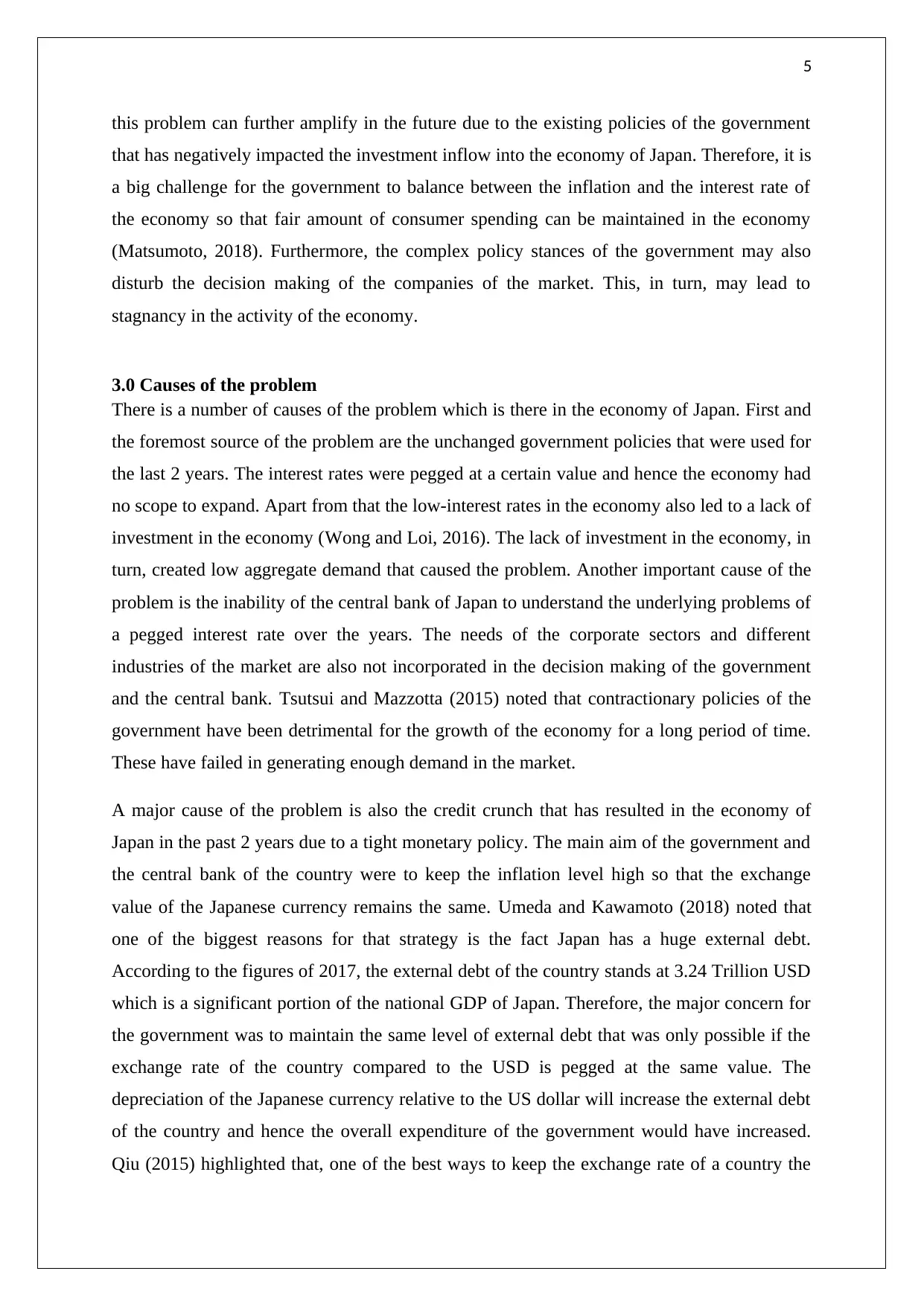
5
this problem can further amplify in the future due to the existing policies of the government
that has negatively impacted the investment inflow into the economy of Japan. Therefore, it is
a big challenge for the government to balance between the inflation and the interest rate of
the economy so that fair amount of consumer spending can be maintained in the economy
(Matsumoto, 2018). Furthermore, the complex policy stances of the government may also
disturb the decision making of the companies of the market. This, in turn, may lead to
stagnancy in the activity of the economy.
3.0 Causes of the problem
There is a number of causes of the problem which is there in the economy of Japan. First and
the foremost source of the problem are the unchanged government policies that were used for
the last 2 years. The interest rates were pegged at a certain value and hence the economy had
no scope to expand. Apart from that the low-interest rates in the economy also led to a lack of
investment in the economy (Wong and Loi, 2016). The lack of investment in the economy, in
turn, created low aggregate demand that caused the problem. Another important cause of the
problem is the inability of the central bank of Japan to understand the underlying problems of
a pegged interest rate over the years. The needs of the corporate sectors and different
industries of the market are also not incorporated in the decision making of the government
and the central bank. Tsutsui and Mazzotta (2015) noted that contractionary policies of the
government have been detrimental for the growth of the economy for a long period of time.
These have failed in generating enough demand in the market.
A major cause of the problem is also the credit crunch that has resulted in the economy of
Japan in the past 2 years due to a tight monetary policy. The main aim of the government and
the central bank of the country were to keep the inflation level high so that the exchange
value of the Japanese currency remains the same. Umeda and Kawamoto (2018) noted that
one of the biggest reasons for that strategy is the fact Japan has a huge external debt.
According to the figures of 2017, the external debt of the country stands at 3.24 Trillion USD
which is a significant portion of the national GDP of Japan. Therefore, the major concern for
the government was to maintain the same level of external debt that was only possible if the
exchange rate of the country compared to the USD is pegged at the same value. The
depreciation of the Japanese currency relative to the US dollar will increase the external debt
of the country and hence the overall expenditure of the government would have increased.
Qiu (2015) highlighted that, one of the best ways to keep the exchange rate of a country the
this problem can further amplify in the future due to the existing policies of the government
that has negatively impacted the investment inflow into the economy of Japan. Therefore, it is
a big challenge for the government to balance between the inflation and the interest rate of
the economy so that fair amount of consumer spending can be maintained in the economy
(Matsumoto, 2018). Furthermore, the complex policy stances of the government may also
disturb the decision making of the companies of the market. This, in turn, may lead to
stagnancy in the activity of the economy.
3.0 Causes of the problem
There is a number of causes of the problem which is there in the economy of Japan. First and
the foremost source of the problem are the unchanged government policies that were used for
the last 2 years. The interest rates were pegged at a certain value and hence the economy had
no scope to expand. Apart from that the low-interest rates in the economy also led to a lack of
investment in the economy (Wong and Loi, 2016). The lack of investment in the economy, in
turn, created low aggregate demand that caused the problem. Another important cause of the
problem is the inability of the central bank of Japan to understand the underlying problems of
a pegged interest rate over the years. The needs of the corporate sectors and different
industries of the market are also not incorporated in the decision making of the government
and the central bank. Tsutsui and Mazzotta (2015) noted that contractionary policies of the
government have been detrimental for the growth of the economy for a long period of time.
These have failed in generating enough demand in the market.
A major cause of the problem is also the credit crunch that has resulted in the economy of
Japan in the past 2 years due to a tight monetary policy. The main aim of the government and
the central bank of the country were to keep the inflation level high so that the exchange
value of the Japanese currency remains the same. Umeda and Kawamoto (2018) noted that
one of the biggest reasons for that strategy is the fact Japan has a huge external debt.
According to the figures of 2017, the external debt of the country stands at 3.24 Trillion USD
which is a significant portion of the national GDP of Japan. Therefore, the major concern for
the government was to maintain the same level of external debt that was only possible if the
exchange rate of the country compared to the USD is pegged at the same value. The
depreciation of the Japanese currency relative to the US dollar will increase the external debt
of the country and hence the overall expenditure of the government would have increased.
Qiu (2015) highlighted that, one of the best ways to keep the exchange rate of a country the
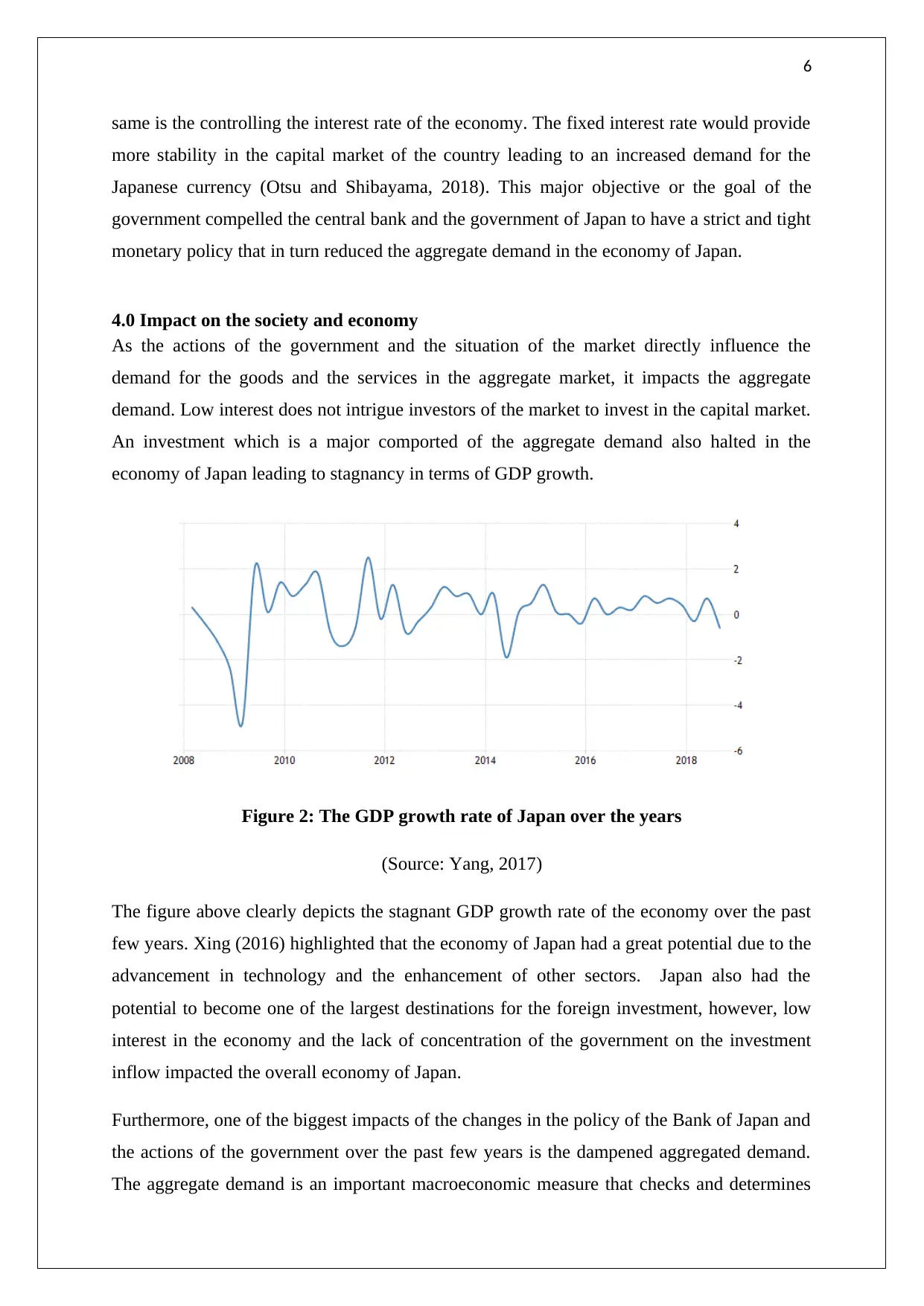
6
same is the controlling the interest rate of the economy. The fixed interest rate would provide
more stability in the capital market of the country leading to an increased demand for the
Japanese currency (Otsu and Shibayama, 2018). This major objective or the goal of the
government compelled the central bank and the government of Japan to have a strict and tight
monetary policy that in turn reduced the aggregate demand in the economy of Japan.
4.0 Impact on the society and economy
As the actions of the government and the situation of the market directly influence the
demand for the goods and the services in the aggregate market, it impacts the aggregate
demand. Low interest does not intrigue investors of the market to invest in the capital market.
An investment which is a major comported of the aggregate demand also halted in the
economy of Japan leading to stagnancy in terms of GDP growth.
Figure 2: The GDP growth rate of Japan over the years
(Source: Yang, 2017)
The figure above clearly depicts the stagnant GDP growth rate of the economy over the past
few years. Xing (2016) highlighted that the economy of Japan had a great potential due to the
advancement in technology and the enhancement of other sectors. Japan also had the
potential to become one of the largest destinations for the foreign investment, however, low
interest in the economy and the lack of concentration of the government on the investment
inflow impacted the overall economy of Japan.
Furthermore, one of the biggest impacts of the changes in the policy of the Bank of Japan and
the actions of the government over the past few years is the dampened aggregated demand.
The aggregate demand is an important macroeconomic measure that checks and determines
same is the controlling the interest rate of the economy. The fixed interest rate would provide
more stability in the capital market of the country leading to an increased demand for the
Japanese currency (Otsu and Shibayama, 2018). This major objective or the goal of the
government compelled the central bank and the government of Japan to have a strict and tight
monetary policy that in turn reduced the aggregate demand in the economy of Japan.
4.0 Impact on the society and economy
As the actions of the government and the situation of the market directly influence the
demand for the goods and the services in the aggregate market, it impacts the aggregate
demand. Low interest does not intrigue investors of the market to invest in the capital market.
An investment which is a major comported of the aggregate demand also halted in the
economy of Japan leading to stagnancy in terms of GDP growth.
Figure 2: The GDP growth rate of Japan over the years
(Source: Yang, 2017)
The figure above clearly depicts the stagnant GDP growth rate of the economy over the past
few years. Xing (2016) highlighted that the economy of Japan had a great potential due to the
advancement in technology and the enhancement of other sectors. Japan also had the
potential to become one of the largest destinations for the foreign investment, however, low
interest in the economy and the lack of concentration of the government on the investment
inflow impacted the overall economy of Japan.
Furthermore, one of the biggest impacts of the changes in the policy of the Bank of Japan and
the actions of the government over the past few years is the dampened aggregated demand.
The aggregate demand is an important macroeconomic measure that checks and determines
⊘ This is a preview!⊘
Do you want full access?
Subscribe today to unlock all pages.

Trusted by 1+ million students worldwide
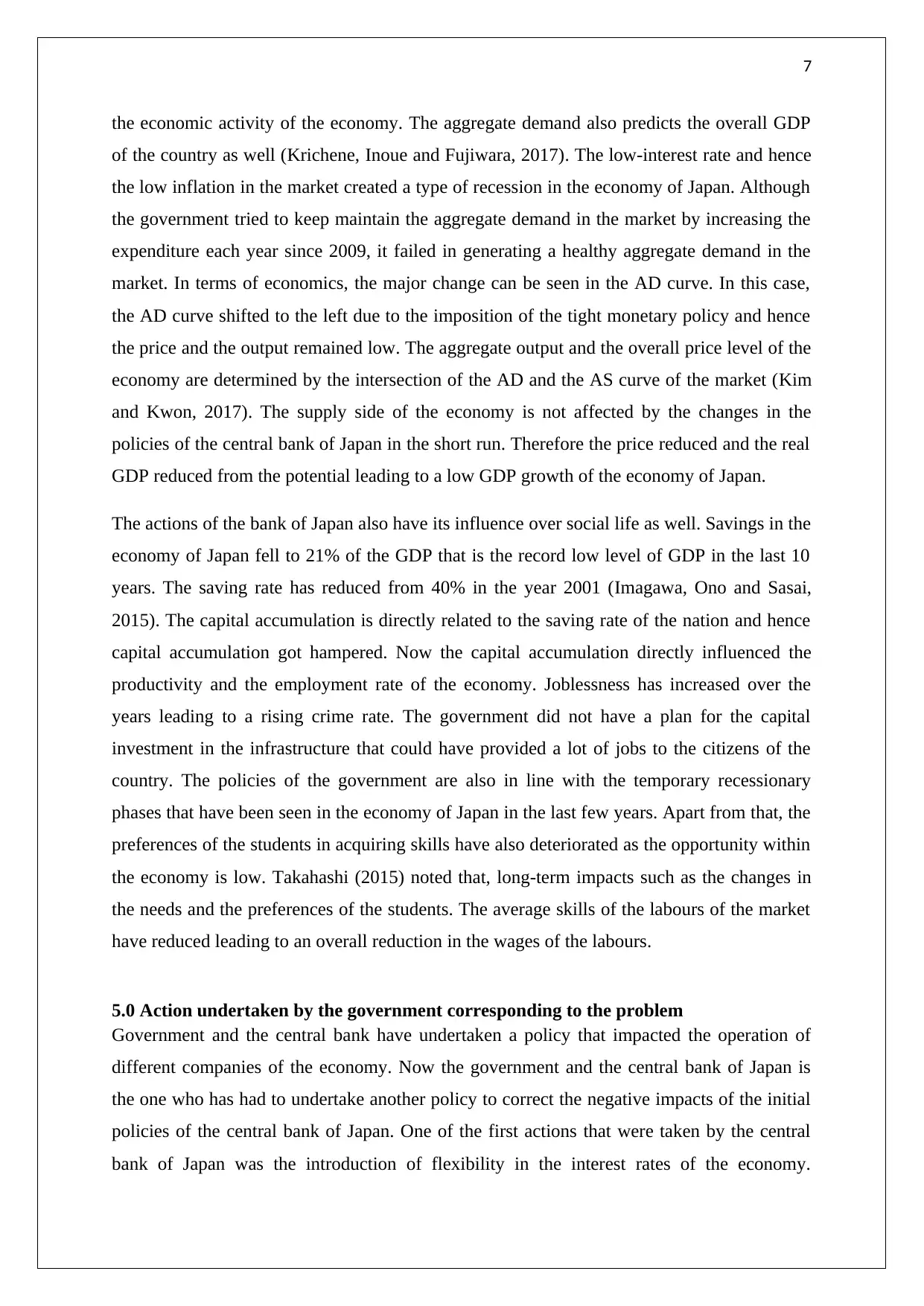
7
the economic activity of the economy. The aggregate demand also predicts the overall GDP
of the country as well (Krichene, Inoue and Fujiwara, 2017). The low-interest rate and hence
the low inflation in the market created a type of recession in the economy of Japan. Although
the government tried to keep maintain the aggregate demand in the market by increasing the
expenditure each year since 2009, it failed in generating a healthy aggregate demand in the
market. In terms of economics, the major change can be seen in the AD curve. In this case,
the AD curve shifted to the left due to the imposition of the tight monetary policy and hence
the price and the output remained low. The aggregate output and the overall price level of the
economy are determined by the intersection of the AD and the AS curve of the market (Kim
and Kwon, 2017). The supply side of the economy is not affected by the changes in the
policies of the central bank of Japan in the short run. Therefore the price reduced and the real
GDP reduced from the potential leading to a low GDP growth of the economy of Japan.
The actions of the bank of Japan also have its influence over social life as well. Savings in the
economy of Japan fell to 21% of the GDP that is the record low level of GDP in the last 10
years. The saving rate has reduced from 40% in the year 2001 (Imagawa, Ono and Sasai,
2015). The capital accumulation is directly related to the saving rate of the nation and hence
capital accumulation got hampered. Now the capital accumulation directly influenced the
productivity and the employment rate of the economy. Joblessness has increased over the
years leading to a rising crime rate. The government did not have a plan for the capital
investment in the infrastructure that could have provided a lot of jobs to the citizens of the
country. The policies of the government are also in line with the temporary recessionary
phases that have been seen in the economy of Japan in the last few years. Apart from that, the
preferences of the students in acquiring skills have also deteriorated as the opportunity within
the economy is low. Takahashi (2015) noted that, long-term impacts such as the changes in
the needs and the preferences of the students. The average skills of the labours of the market
have reduced leading to an overall reduction in the wages of the labours.
5.0 Action undertaken by the government corresponding to the problem
Government and the central bank have undertaken a policy that impacted the operation of
different companies of the economy. Now the government and the central bank of Japan is
the one who has had to undertake another policy to correct the negative impacts of the initial
policies of the central bank of Japan. One of the first actions that were taken by the central
bank of Japan was the introduction of flexibility in the interest rates of the economy.
the economic activity of the economy. The aggregate demand also predicts the overall GDP
of the country as well (Krichene, Inoue and Fujiwara, 2017). The low-interest rate and hence
the low inflation in the market created a type of recession in the economy of Japan. Although
the government tried to keep maintain the aggregate demand in the market by increasing the
expenditure each year since 2009, it failed in generating a healthy aggregate demand in the
market. In terms of economics, the major change can be seen in the AD curve. In this case,
the AD curve shifted to the left due to the imposition of the tight monetary policy and hence
the price and the output remained low. The aggregate output and the overall price level of the
economy are determined by the intersection of the AD and the AS curve of the market (Kim
and Kwon, 2017). The supply side of the economy is not affected by the changes in the
policies of the central bank of Japan in the short run. Therefore the price reduced and the real
GDP reduced from the potential leading to a low GDP growth of the economy of Japan.
The actions of the bank of Japan also have its influence over social life as well. Savings in the
economy of Japan fell to 21% of the GDP that is the record low level of GDP in the last 10
years. The saving rate has reduced from 40% in the year 2001 (Imagawa, Ono and Sasai,
2015). The capital accumulation is directly related to the saving rate of the nation and hence
capital accumulation got hampered. Now the capital accumulation directly influenced the
productivity and the employment rate of the economy. Joblessness has increased over the
years leading to a rising crime rate. The government did not have a plan for the capital
investment in the infrastructure that could have provided a lot of jobs to the citizens of the
country. The policies of the government are also in line with the temporary recessionary
phases that have been seen in the economy of Japan in the last few years. Apart from that, the
preferences of the students in acquiring skills have also deteriorated as the opportunity within
the economy is low. Takahashi (2015) noted that, long-term impacts such as the changes in
the needs and the preferences of the students. The average skills of the labours of the market
have reduced leading to an overall reduction in the wages of the labours.
5.0 Action undertaken by the government corresponding to the problem
Government and the central bank have undertaken a policy that impacted the operation of
different companies of the economy. Now the government and the central bank of Japan is
the one who has had to undertake another policy to correct the negative impacts of the initial
policies of the central bank of Japan. One of the first actions that were taken by the central
bank of Japan was the introduction of flexibility in the interest rates of the economy.
Paraphrase This Document
Need a fresh take? Get an instant paraphrase of this document with our AI Paraphraser
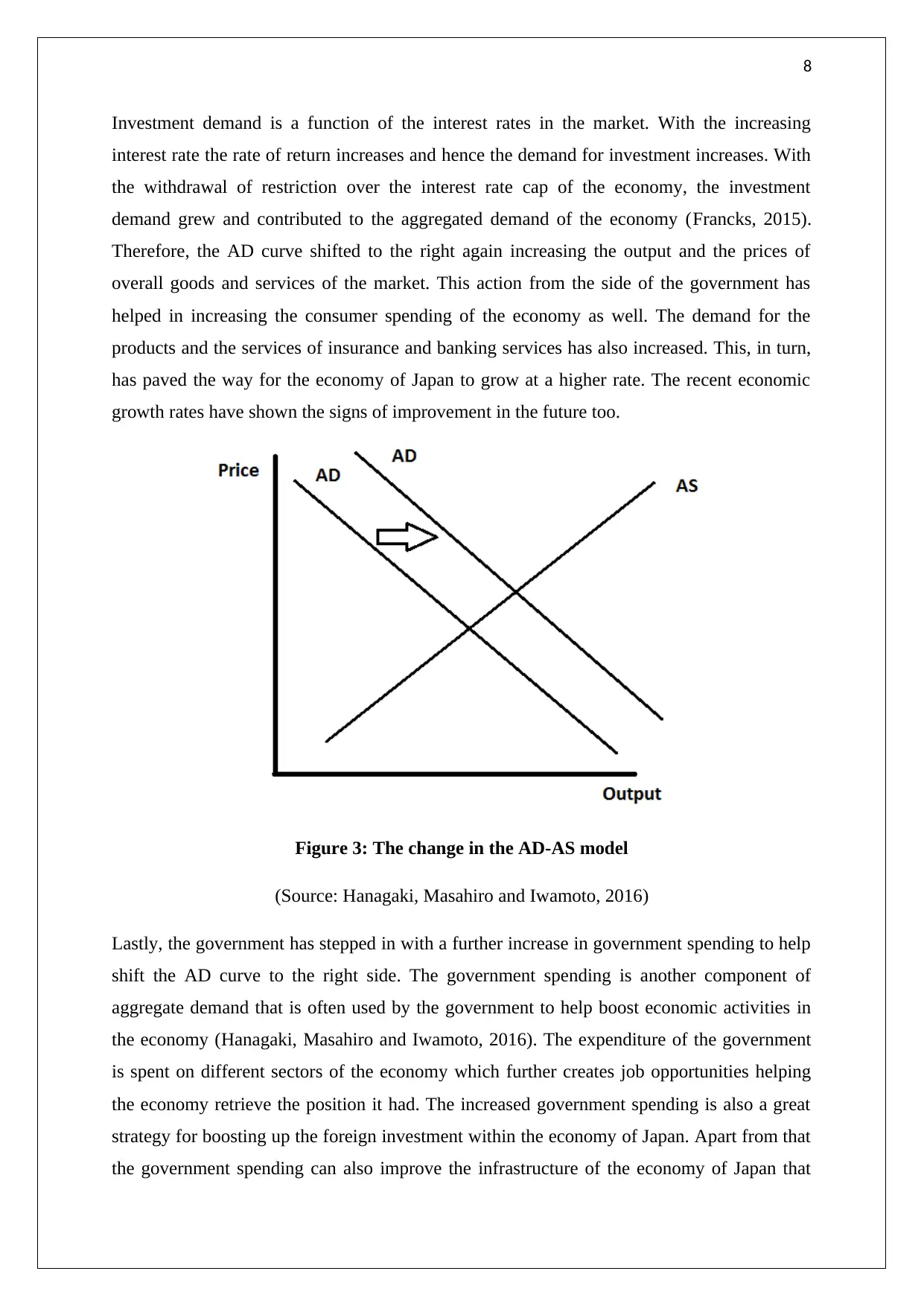
8
Investment demand is a function of the interest rates in the market. With the increasing
interest rate the rate of return increases and hence the demand for investment increases. With
the withdrawal of restriction over the interest rate cap of the economy, the investment
demand grew and contributed to the aggregated demand of the economy (Francks, 2015).
Therefore, the AD curve shifted to the right again increasing the output and the prices of
overall goods and services of the market. This action from the side of the government has
helped in increasing the consumer spending of the economy as well. The demand for the
products and the services of insurance and banking services has also increased. This, in turn,
has paved the way for the economy of Japan to grow at a higher rate. The recent economic
growth rates have shown the signs of improvement in the future too.
Figure 3: The change in the AD-AS model
(Source: Hanagaki, Masahiro and Iwamoto, 2016)
Lastly, the government has stepped in with a further increase in government spending to help
shift the AD curve to the right side. The government spending is another component of
aggregate demand that is often used by the government to help boost economic activities in
the economy (Hanagaki, Masahiro and Iwamoto, 2016). The expenditure of the government
is spent on different sectors of the economy which further creates job opportunities helping
the economy retrieve the position it had. The increased government spending is also a great
strategy for boosting up the foreign investment within the economy of Japan. Apart from that
the government spending can also improve the infrastructure of the economy of Japan that
Investment demand is a function of the interest rates in the market. With the increasing
interest rate the rate of return increases and hence the demand for investment increases. With
the withdrawal of restriction over the interest rate cap of the economy, the investment
demand grew and contributed to the aggregated demand of the economy (Francks, 2015).
Therefore, the AD curve shifted to the right again increasing the output and the prices of
overall goods and services of the market. This action from the side of the government has
helped in increasing the consumer spending of the economy as well. The demand for the
products and the services of insurance and banking services has also increased. This, in turn,
has paved the way for the economy of Japan to grow at a higher rate. The recent economic
growth rates have shown the signs of improvement in the future too.
Figure 3: The change in the AD-AS model
(Source: Hanagaki, Masahiro and Iwamoto, 2016)
Lastly, the government has stepped in with a further increase in government spending to help
shift the AD curve to the right side. The government spending is another component of
aggregate demand that is often used by the government to help boost economic activities in
the economy (Hanagaki, Masahiro and Iwamoto, 2016). The expenditure of the government
is spent on different sectors of the economy which further creates job opportunities helping
the economy retrieve the position it had. The increased government spending is also a great
strategy for boosting up the foreign investment within the economy of Japan. Apart from that
the government spending can also improve the infrastructure of the economy of Japan that
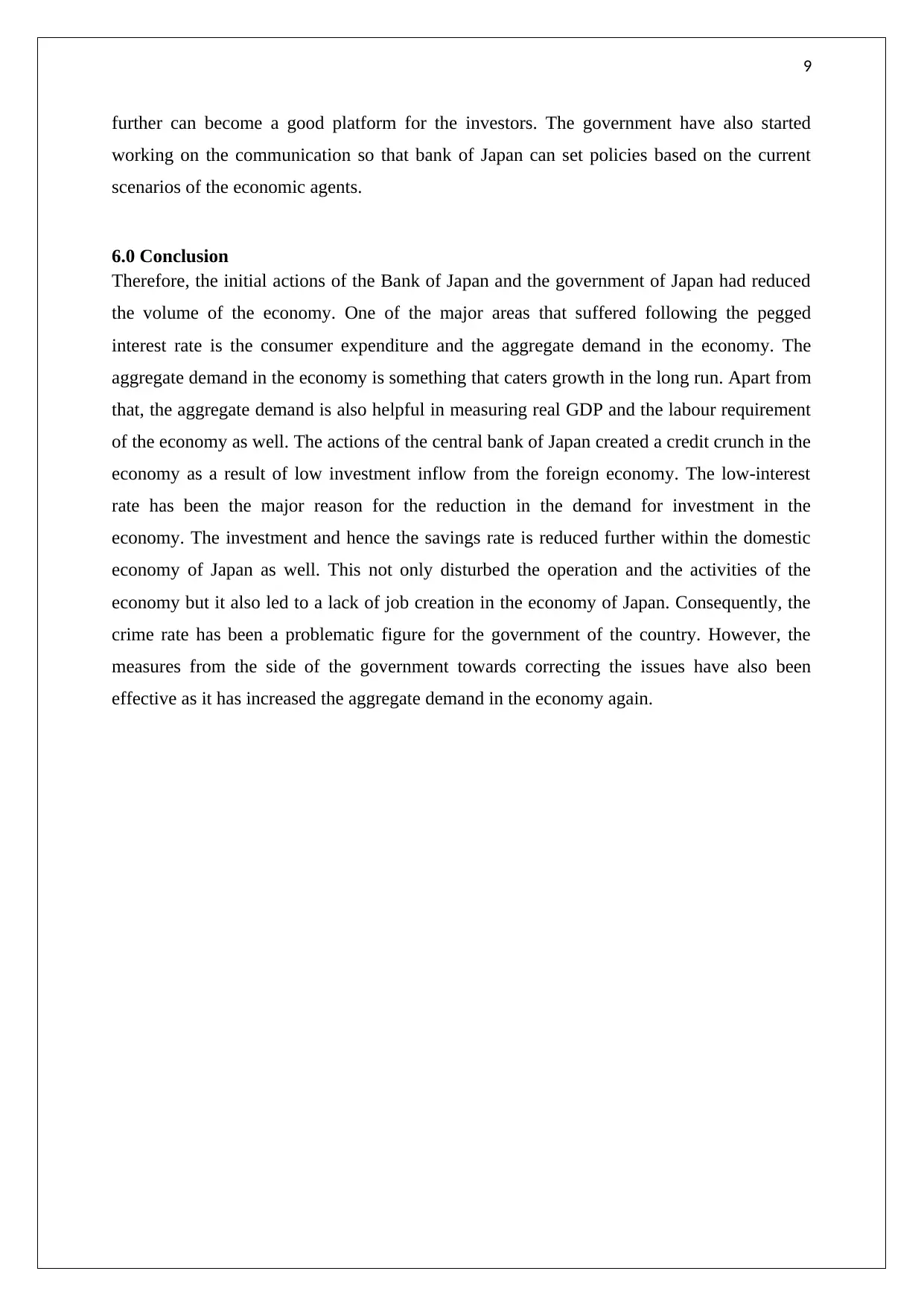
9
further can become a good platform for the investors. The government have also started
working on the communication so that bank of Japan can set policies based on the current
scenarios of the economic agents.
6.0 Conclusion
Therefore, the initial actions of the Bank of Japan and the government of Japan had reduced
the volume of the economy. One of the major areas that suffered following the pegged
interest rate is the consumer expenditure and the aggregate demand in the economy. The
aggregate demand in the economy is something that caters growth in the long run. Apart from
that, the aggregate demand is also helpful in measuring real GDP and the labour requirement
of the economy as well. The actions of the central bank of Japan created a credit crunch in the
economy as a result of low investment inflow from the foreign economy. The low-interest
rate has been the major reason for the reduction in the demand for investment in the
economy. The investment and hence the savings rate is reduced further within the domestic
economy of Japan as well. This not only disturbed the operation and the activities of the
economy but it also led to a lack of job creation in the economy of Japan. Consequently, the
crime rate has been a problematic figure for the government of the country. However, the
measures from the side of the government towards correcting the issues have also been
effective as it has increased the aggregate demand in the economy again.
further can become a good platform for the investors. The government have also started
working on the communication so that bank of Japan can set policies based on the current
scenarios of the economic agents.
6.0 Conclusion
Therefore, the initial actions of the Bank of Japan and the government of Japan had reduced
the volume of the economy. One of the major areas that suffered following the pegged
interest rate is the consumer expenditure and the aggregate demand in the economy. The
aggregate demand in the economy is something that caters growth in the long run. Apart from
that, the aggregate demand is also helpful in measuring real GDP and the labour requirement
of the economy as well. The actions of the central bank of Japan created a credit crunch in the
economy as a result of low investment inflow from the foreign economy. The low-interest
rate has been the major reason for the reduction in the demand for investment in the
economy. The investment and hence the savings rate is reduced further within the domestic
economy of Japan as well. This not only disturbed the operation and the activities of the
economy but it also led to a lack of job creation in the economy of Japan. Consequently, the
crime rate has been a problematic figure for the government of the country. However, the
measures from the side of the government towards correcting the issues have also been
effective as it has increased the aggregate demand in the economy again.
⊘ This is a preview!⊘
Do you want full access?
Subscribe today to unlock all pages.

Trusted by 1+ million students worldwide
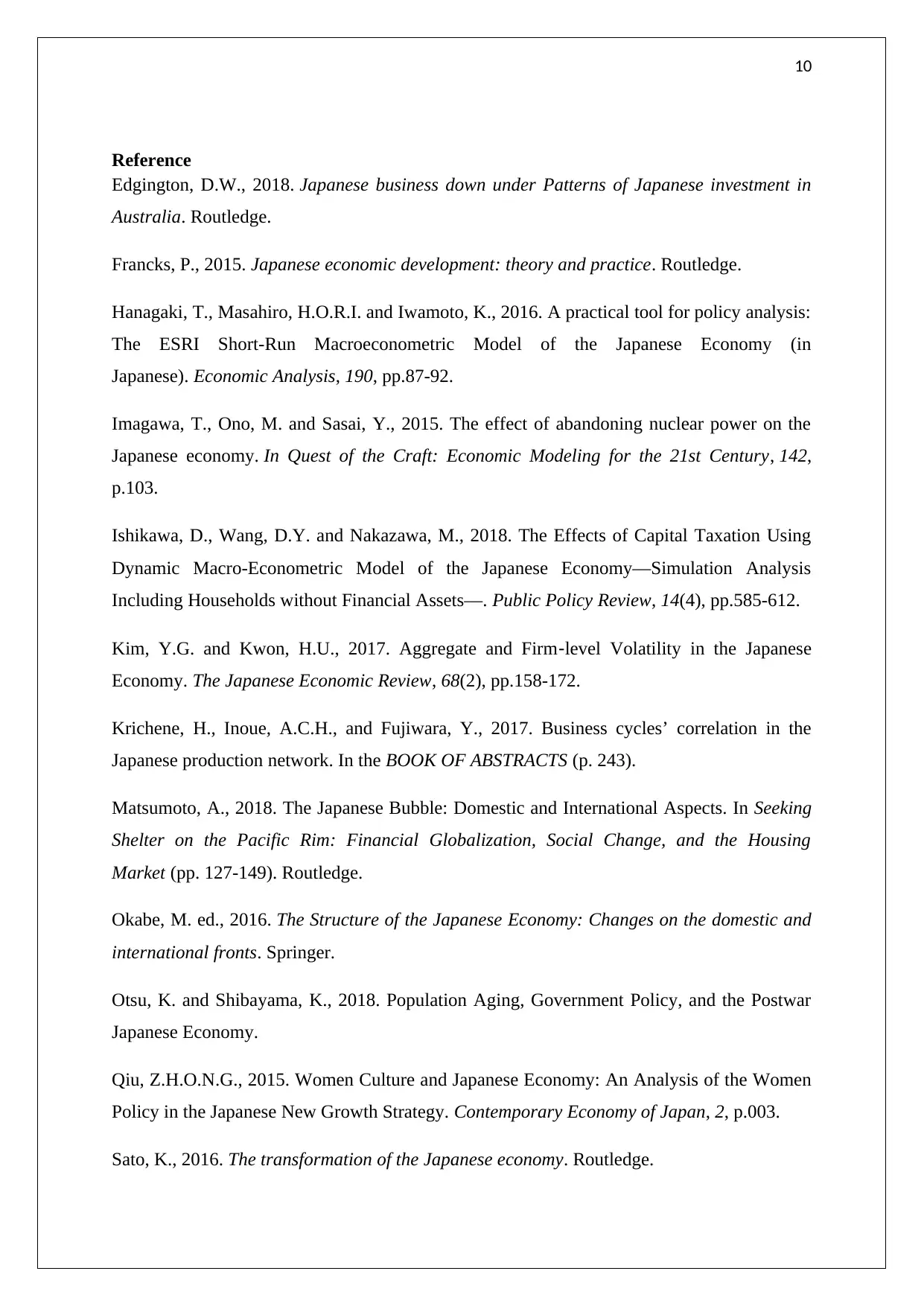
10
Reference
Edgington, D.W., 2018. Japanese business down under Patterns of Japanese investment in
Australia. Routledge.
Francks, P., 2015. Japanese economic development: theory and practice. Routledge.
Hanagaki, T., Masahiro, H.O.R.I. and Iwamoto, K., 2016. A practical tool for policy analysis:
The ESRI Short-Run Macroeconometric Model of the Japanese Economy (in
Japanese). Economic Analysis, 190, pp.87-92.
Imagawa, T., Ono, M. and Sasai, Y., 2015. The effect of abandoning nuclear power on the
Japanese economy. In Quest of the Craft: Economic Modeling for the 21st Century, 142,
p.103.
Ishikawa, D., Wang, D.Y. and Nakazawa, M., 2018. The Effects of Capital Taxation Using
Dynamic Macro-Econometric Model of the Japanese Economy―Simulation Analysis
Including Households without Financial Assets―. Public Policy Review, 14(4), pp.585-612.
Kim, Y.G. and Kwon, H.U., 2017. Aggregate and Firm‐level Volatility in the Japanese
Economy. The Japanese Economic Review, 68(2), pp.158-172.
Krichene, H., Inoue, A.C.H., and Fujiwara, Y., 2017. Business cycles’ correlation in the
Japanese production network. In the BOOK OF ABSTRACTS (p. 243).
Matsumoto, A., 2018. The Japanese Bubble: Domestic and International Aspects. In Seeking
Shelter on the Pacific Rim: Financial Globalization, Social Change, and the Housing
Market (pp. 127-149). Routledge.
Okabe, M. ed., 2016. The Structure of the Japanese Economy: Changes on the domestic and
international fronts. Springer.
Otsu, K. and Shibayama, K., 2018. Population Aging, Government Policy, and the Postwar
Japanese Economy.
Qiu, Z.H.O.N.G., 2015. Women Culture and Japanese Economy: An Analysis of the Women
Policy in the Japanese New Growth Strategy. Contemporary Economy of Japan, 2, p.003.
Sato, K., 2016. The transformation of the Japanese economy. Routledge.
Reference
Edgington, D.W., 2018. Japanese business down under Patterns of Japanese investment in
Australia. Routledge.
Francks, P., 2015. Japanese economic development: theory and practice. Routledge.
Hanagaki, T., Masahiro, H.O.R.I. and Iwamoto, K., 2016. A practical tool for policy analysis:
The ESRI Short-Run Macroeconometric Model of the Japanese Economy (in
Japanese). Economic Analysis, 190, pp.87-92.
Imagawa, T., Ono, M. and Sasai, Y., 2015. The effect of abandoning nuclear power on the
Japanese economy. In Quest of the Craft: Economic Modeling for the 21st Century, 142,
p.103.
Ishikawa, D., Wang, D.Y. and Nakazawa, M., 2018. The Effects of Capital Taxation Using
Dynamic Macro-Econometric Model of the Japanese Economy―Simulation Analysis
Including Households without Financial Assets―. Public Policy Review, 14(4), pp.585-612.
Kim, Y.G. and Kwon, H.U., 2017. Aggregate and Firm‐level Volatility in the Japanese
Economy. The Japanese Economic Review, 68(2), pp.158-172.
Krichene, H., Inoue, A.C.H., and Fujiwara, Y., 2017. Business cycles’ correlation in the
Japanese production network. In the BOOK OF ABSTRACTS (p. 243).
Matsumoto, A., 2018. The Japanese Bubble: Domestic and International Aspects. In Seeking
Shelter on the Pacific Rim: Financial Globalization, Social Change, and the Housing
Market (pp. 127-149). Routledge.
Okabe, M. ed., 2016. The Structure of the Japanese Economy: Changes on the domestic and
international fronts. Springer.
Otsu, K. and Shibayama, K., 2018. Population Aging, Government Policy, and the Postwar
Japanese Economy.
Qiu, Z.H.O.N.G., 2015. Women Culture and Japanese Economy: An Analysis of the Women
Policy in the Japanese New Growth Strategy. Contemporary Economy of Japan, 2, p.003.
Sato, K., 2016. The transformation of the Japanese economy. Routledge.
Paraphrase This Document
Need a fresh take? Get an instant paraphrase of this document with our AI Paraphraser
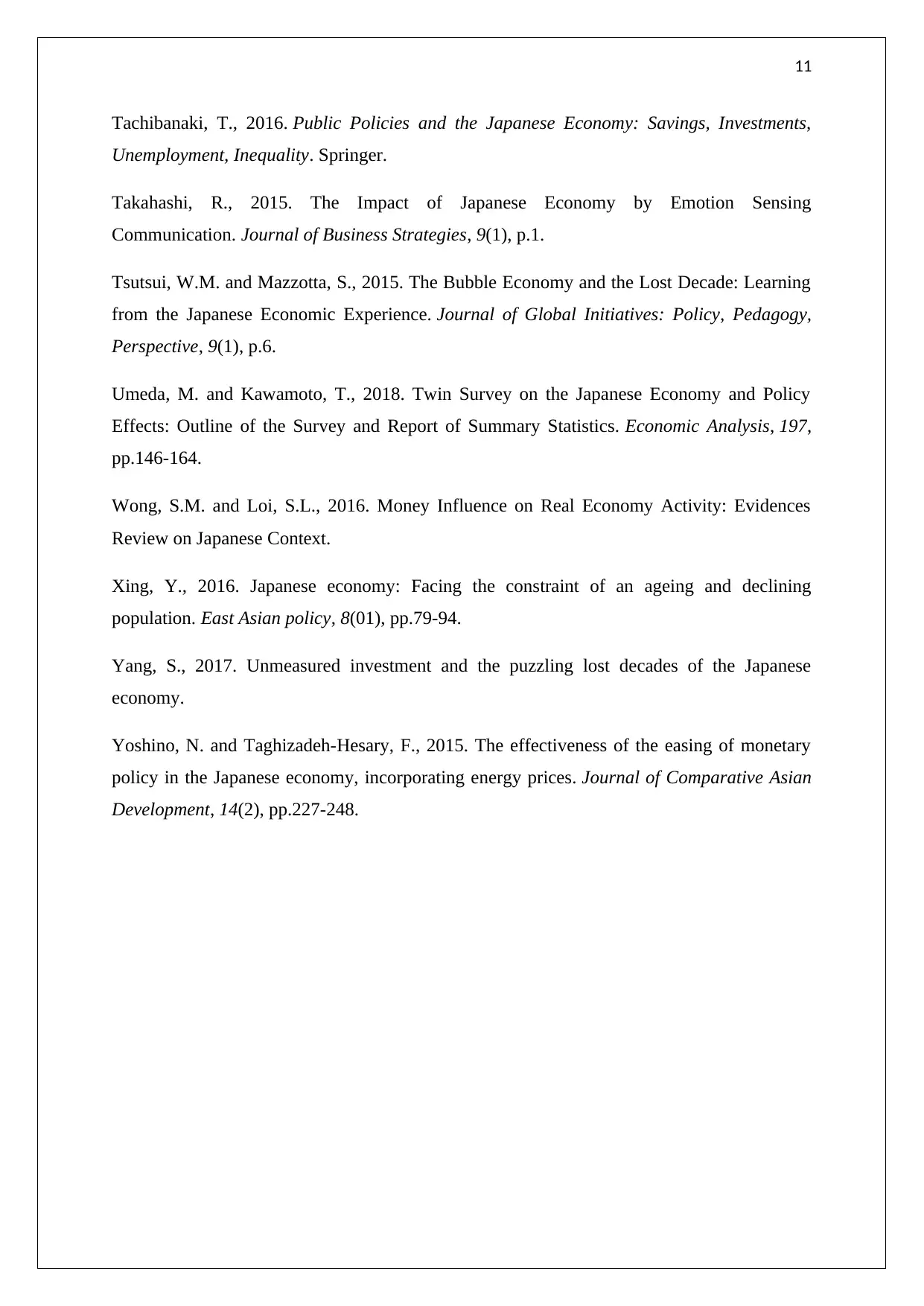
11
Tachibanaki, T., 2016. Public Policies and the Japanese Economy: Savings, Investments,
Unemployment, Inequality. Springer.
Takahashi, R., 2015. The Impact of Japanese Economy by Emotion Sensing
Communication. Journal of Business Strategies, 9(1), p.1.
Tsutsui, W.M. and Mazzotta, S., 2015. The Bubble Economy and the Lost Decade: Learning
from the Japanese Economic Experience. Journal of Global Initiatives: Policy, Pedagogy,
Perspective, 9(1), p.6.
Umeda, M. and Kawamoto, T., 2018. Twin Survey on the Japanese Economy and Policy
Effects: Outline of the Survey and Report of Summary Statistics. Economic Analysis, 197,
pp.146-164.
Wong, S.M. and Loi, S.L., 2016. Money Influence on Real Economy Activity: Evidences
Review on Japanese Context.
Xing, Y., 2016. Japanese economy: Facing the constraint of an ageing and declining
population. East Asian policy, 8(01), pp.79-94.
Yang, S., 2017. Unmeasured investment and the puzzling lost decades of the Japanese
economy.
Yoshino, N. and Taghizadeh-Hesary, F., 2015. The effectiveness of the easing of monetary
policy in the Japanese economy, incorporating energy prices. Journal of Comparative Asian
Development, 14(2), pp.227-248.
Tachibanaki, T., 2016. Public Policies and the Japanese Economy: Savings, Investments,
Unemployment, Inequality. Springer.
Takahashi, R., 2015. The Impact of Japanese Economy by Emotion Sensing
Communication. Journal of Business Strategies, 9(1), p.1.
Tsutsui, W.M. and Mazzotta, S., 2015. The Bubble Economy and the Lost Decade: Learning
from the Japanese Economic Experience. Journal of Global Initiatives: Policy, Pedagogy,
Perspective, 9(1), p.6.
Umeda, M. and Kawamoto, T., 2018. Twin Survey on the Japanese Economy and Policy
Effects: Outline of the Survey and Report of Summary Statistics. Economic Analysis, 197,
pp.146-164.
Wong, S.M. and Loi, S.L., 2016. Money Influence on Real Economy Activity: Evidences
Review on Japanese Context.
Xing, Y., 2016. Japanese economy: Facing the constraint of an ageing and declining
population. East Asian policy, 8(01), pp.79-94.
Yang, S., 2017. Unmeasured investment and the puzzling lost decades of the Japanese
economy.
Yoshino, N. and Taghizadeh-Hesary, F., 2015. The effectiveness of the easing of monetary
policy in the Japanese economy, incorporating energy prices. Journal of Comparative Asian
Development, 14(2), pp.227-248.
1 out of 11
Related Documents
Your All-in-One AI-Powered Toolkit for Academic Success.
+13062052269
info@desklib.com
Available 24*7 on WhatsApp / Email
![[object Object]](/_next/static/media/star-bottom.7253800d.svg)
Unlock your academic potential
Copyright © 2020–2025 A2Z Services. All Rights Reserved. Developed and managed by ZUCOL.




